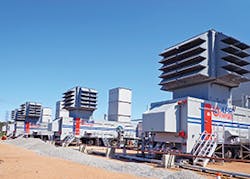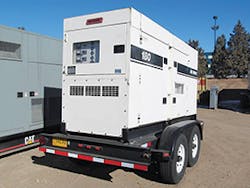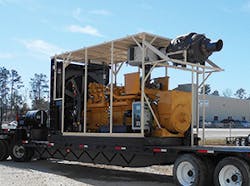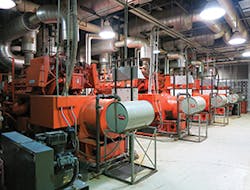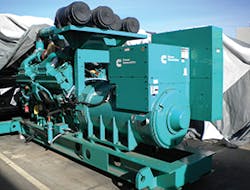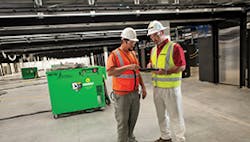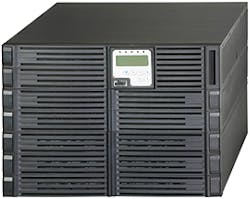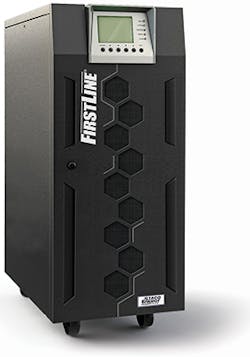Introduction
If severe weather teaches us anything, it reminds us of the fragility of the energy infrastructure that civilization depends on. From super storm “Sandy,” to the recent brutal winter of 2014, the power of Mother Nature trumps human sophistication. As someone who has experienced a loss of electrical power in his home for an extended period after a tornado, I have developed a keen appreciation for the role of electricity in our lives. It is not to be taken for granted, ever. Until it happens to you, it is easy to forget how easily you can be thrown back a century technologically as a result of a storm. And that is just for individual’s homes. These same storms can knock out power to critical industrial and commercial facilities as well, leading to significant secondary economic losses ranging from the bursting of pipes that have been frozen due to lack of heat, to food spoiled due to lack of refrigeration. For these instances, small, mobile electrical power sources called “gensets” and their associated equipment, load banks, are invaluable.
What Are Gensets?
Gensets are portable electrical power sources. They consist of three primary components. The first is an electrical generator that produces the electrical power. The second is a reciprocating engine (usually an internal combustion engine, although turbines can also be used) that drives the generator. Both are mounted together to form a complete power unit. The third is the fuel that runs the engine. Usually this is diesel fuel for larger gensets and gasoline for smaller ones (though other fuels such as natural gas, propane, biodiesel, hydrogen, and even sewer gas can be used). The name “genset” derives from the term “engine generator set.” Typically, the entire unit is simply referred to as a generator. And in the United States, this usually means a portable single-phase genset, with three-phase generators limited to larger immobile units.
Auxiliary systems necessary to the proper functioning of a genset include a speed regulator (or governor), a voltage regulator, coolant system, exhaust vents, an engine lubrication system, a battery starter for smaller gensets, and compressed air starters for larger ones. Gensets prepositioned for standby power service utilize automatic starting switches that also immediately disconnect the service load from the grid to the genset when a power failure occurs. Speed regulators are necessary to ensure constant engine speed, which further ensures that the output frequency of the generator part of the genset stays consistent.
Gensets typically utilize regulators that limit the amount of fuel and air being fed to the engine. Types of regulators include an electronic servo motor whose electronic module can sense engine speed (from counting the frequency of spark plug discharges), which sends proportional voltage back to the servo to control engine speed; pneumatic regulators that measure an engine’s output air stream and vary the carburetor’s intake throttle to increase and decrease air flow until equilibrium is achieved; and a centrifugal fly weight mechanism linked to a spring that regulates engine speed in a way similar to that of a pneumatic regulator.
Voltage (along with power and frequency) has to match anticipated load connections. Voltage regulators further ensure a consistent power output by maintaining a constant voltage level. They are designed to compare the actual voltage output with an internal fixed reference voltage. The regulator will cause the alternator to produce more voltage if actual voltage is lower than the preset standard. This ensures the production of a constant and safe level of voltage.
What Are Load Banks?
“Look before you leap” is a time honored saying with particular applicability to genset operations. Gensets tend to sit around unused for long periods of time. In their mothballed condition, there is no way for an operator to know for sure if it will work as advertised. Waiting to test the genset’s capabilities just as it is needed is extremely risky. And that is where load banks come in.
A load bank is an auxiliary device that uses its energy to analyze and regulate a power source. Put simply, it is a device that develops and applies an electric load (an electric circuit with an output terminal) to an electrical power source (such as a genset). It is designed to mimic a real load that the power source will service in a controlled and contained application. These loads fall into several categories. Battery discharge testers are used to test batteries by discharging them under specified operating parameters. Certain types of load banks are used in laboratories to test various types of devices and systems (including those design specifically to test advanced aerospace generators and equipment). And, lastly, there is the large-scale load bank that tests both alternating current (AC) and direct current (DC) power sources and generators, as well as electrical equipment such as relays and breakers.
So what do load banks have to do with gensets-why are they necessary? Load banks are necessary (and often required by code) to test backup power systems to ensure their proper performance. Gensets may operate adequately under light load but may fail when called upon to deliver a full load. This would be a critical failure of standby, safety, and medical systems. Furthermore, a well-developed load bank should mimic the actual system that will receive the backup power from the genset. Only then can an operator have a high degree of assurance that the system will operate as needed during an emergency.
The three basic types of load banks are resistive, inductive, and capacitive.
- Resistive load banks are the most common type of load bank and are usually used for testing fixed loads (such as battery discharge testers). They provide loads equally to both the generator and engine (the prime mover of the genset). In other words, if an engine has a load of 100 kW (134 hp) applied to it by the generator, the load applied to the generator by the load bank is also 100 kW. In a resistive loan bank, energy is removed from the entire genset-fuel to engine, to generator, to load bank. Taking into account the waste heat from the coolant system, auxiliary devices and controls, exhaust venting, etc., a resistive load bank allows for a test of the system as a whole. What exactly is the “load” that the resistive load bank is applying to the genset? It is the work required to convert electrical energy into heat by resistors. This heat is radiated away from the load bank by means of air or water coolant systems using forced means or convection. The arrangement and inherent resistivity of the resistors (measured in ohms) is designed to mimic actual electrical systems needs (heating, lighting, machine operations, etc.)
- Inductive load banks used in conjunction with elements of a resistive load bank create a lagging power factor load. The heart of an inductive load bank are iron core reactive elements that typically create a magnetic inductive load that is approximately 75% of the corresponding resistive load (though other power ratios are commercially available). So for every 100 kW of applied real power supplied by the resistive load, 75 kVAR (kilo volt amps, resistive) of apparent reactive power is provided. The inductive loads simulate actual mixed commercial loads that would include motors, transformers, and equipment, in addition to basic heating and lighting. This allows for full power system testing including the effects of reactive currents, conductors, and switches on the genset’s voltage regulator.
- Capacitive load banks are also used in conjunction with reactive load banks and can be added to inductive load banks. Capacitive loads are comprised of created electrical loads and are used to simulate loads from electronics or non-linear loads found in telecommunications and computer systems.
Major Suppliers of Gensets and Genset Related Products
APR Energy provides mobile turbine power to customers worldwide. Their turnkey plants are easily deployable, customizable, and scalable. Delivery, setup, and production can be accomplished in days, or weeks. The featured product is the GE TM2500+. This highly mobile aero-derivative turbine is capable of producing up to 31 MW of power, which it can achieve in less than 10 minutes. It was developed specifically for rapid deployment and mobile power, is delivered in a two-trailer transport, and occupies a footprint of only 78 by 21 feet. Its high-power density and scalability allow for the rapid delivery of 300 MW of energy or more that can be quickly integrated into existing infrastructure and can operate on a semi-permanent basis. Turbines, unlike reciprocating engines, are fuel flexible and can use either diesel or natural gas. The GE TM2500+ also offers operational flexibility and can be converted from 50 to 60 Hz. The unit also offers the option of water injection for NOx suppression down to 25 ppm. Turbines produce less exhaust emissions and noise, allowing for their use in markets and locations with strict regulatory standards.
Biobor is a leader in the niche market of supplying fuel additives for gensets. This is considered to be a severe application for fuels. Often sitting idle for months at a time, the stored fuel is also subject to long term storage and lack of turn over through use or circulation. The water created by condensation and the scum formed by microbial growth can lead to corrosion of engine parts and the clogging of fuel filters. Their Biobor JF is the most widely used diesel biocide and lubricity additive to kill and prevent bacterial growth while also providing essential lubrication to injectors and fuel pumps. With continued use, standby fuel will remain on spec and free from filter clogging slime and the tank corrosion that follows. Biobor also offers a diesel conditioner, Biobor MD, providing additional stability, water control, corrosion inhibitors, cetane boost, and injector cleaners.
Blue Star Power Systems is a provider of high-quality generator sets with a commitment to managing all of their operations in a safe and environmentally sound manner. The company’s UL2200 listing is a comprehensive safety standard encompassing the design, construction, and performance of stationary generators. In doing so, it meets both fuel efficiency goals and EPA emissions standards. Blue Star offers diesel generator sets available ranging from 20 to 2,500 kW, both standard and customized products. The gaseous generator sets range from 25 to 425 kW. Special applications that require gaseous options because of local fuel codes, containment or customer preferences are available in natural gas, propane, and combined fuel settings. Blue Star’s digital genset controller (DGC-2020) is an integrated genset control system that combines rugged construction and microprocessor technology to offer a product that will hold up to any environment and is flexible enough to meet multiple application’s needs. This device provides genset control, transfer, switch control, metering, protection, and programmable logic with optional remote communications.
Depco Power Systems has been a dealer in new, used, and rebuilt genset equipment since 1991. Their product line from leading industry bands such as Caterpillar, Cummins, Detroit Diesel, and Atlas Copco includes power equipment such as used diesel generators and engines, natural gas generators and engines, marine engines and transmissions, power units, and transfer switches.
Atlas Copco provides sustainable productivity solutions to customers in 180 countries. The company’s services emphasize productivity, energy efficiency, safety, and ergonomics. Manufacturing standards follow ISO 9001 quality assurance regulations. All components are produced and tested to ensure optimum performance in demanding environments. The QAC 1200 genset packs a powerful, yet compact power generator for onsite and critical standby power applications. The flexible power range of the QAC allows for customized systems for particular applications. The QAC 1200’s rated prime power is 1,140 kVA per 912 kW with rated Standby Power: 1,254 kVA per 1,003 kW. Its engine is a CUMMINS QST30 G5 (rated as EPA_Tier2). It comes equipped with a Leroy Somer LSA49.1L11 alternator and a daily fuel tank with a 370-gallon capacity. The QAS 70-150 can power a variety of critical applications. With 500 hours service intervals and efficient transport and handling, the QAS provides reduced cost of ownership.
GE‘s Jenbacher gas engines product line, which is part of GE’s Distributed Power business, has been a worldwide provider of high efficiency gas engines up to the 10-MW range for over 50 years. These are flexible application gensets designed to run on different types of gas (natural gas, biogas, coal seam gas, and petroleum gas) for different types of applications. The company’s innovative designs include the world’s first 20-cylinder gas engine, the world’s first 24-cylinder gas engine, the world’s first two-turbocharger gas engine, and a high-efficiency four-series concept.
Global Power Supply (GPS) is a full service provider of integrated power systems including diesel generators, natural gas generators, genset enclosures, fuel tanks, automatic transfer switches, HVAC units, computer room air-conditioning (CRAC) systems, and paralleling switchgear. The company also purchases new, surplus, and used industrial diesel generators, natural gas generators, and dual fuel generators from major suppliers (Caterpillar, Cummins, Kohler, Waukesha, MQ Power, MTU, etc.), and deals in chillers, power distribution units, automatic transfer switches, and UPS systems.
Sunbelt Rentals provides generators for a number of power applications capable of supplying efficient, continuous-duty solutions for temporary, standby, and emergency power requirements. The company’s line of diesel industrial generators ranges from 350 kW to 2,000 kW. Even larger capacity requirements can be met by multiple units since these are designed to be parallelable. Operating at 60 hertz, the generators are powered by engines ranging in size from a Volvo 755 hp for the 500-kW unit, to a giant Detroit engine used by the 2,000-kW unit. In addition to power, Sunbelt also provides sound attenuated generators. These specialty diesel silenced generators have found a home in the niche market of providing power to movie sets and other locations where background noise is forbidden, also providing ultra-quiet operation and extremely clean power for noise and voltage/frequency sensitive applications. The 500- and 1,400-amp generators are powered by a Cummins 93-hp and Volvo 250-hp engine, respectively. At the smaller scale is the varied line of Towable Diesel Generators. These mobile units provide solutions for temporary, standby, and emergency power requirements ranging from 20 kW to 640 kW and are equipped with tandem-axle trailers that allow for safe and easy towing at highway speeds. All models feature quiet operation and on-board fuel capacity.
Sunbelt Rentals is also committed to making green choices. To achieve lower GHG emissions, the company provides a new line of natural gaspowered generators. This commitment to the environment matches its commitment to customers, as evidenced by the experience of a large electrical contractor.
Among United Rental‘s varied product lines are light towers, the generators and portable generators for generic applications. These are relatively small, but highly mobile, units that can be easily sited in any work environment. The diesel fuel-powered towable generators range in power from 1929 kVA, to 125149 kVA. Smaller, manually placed generators are also available. These are gasoline-powered units ranging in size from
2.0-kVA to 9.9-kVA units.
Tradewinds Power Corp. is an original equipment manufacturer of diesel and natural gas generator sets, diesel power units and pump sets, along with marine generator sets and propulsion engines. The UL 2200 certification ensures compliance with bid specifications for US standby generator set assemblies. Available in a wide range of capacity and horsepower, these diesel-fueled generators range from 9 kW to several megawatts. The company’s gasoline generators are powered by reliable GM and Doosan engines.
Major Suppliers of Load Banks
Avtron Loadbanks. Most Avtron resistive load banks feature Helidyne resistive elements. These Avtron designed and manufactured elements are made of a corrosion resistant chromium alloy and are fully supported across their entire length on stainless steel support rods with segmented ceramic insulators. Elements are carefully selected to operate at low temperatures to provide extended, reliable performance, eliminating the need for a “cool down” period after load bank operation. Avtron stresses that load banks can be used in a wide variety of applications, such as factory testing of engine generator sets, reducing “wet stacking” problems, periodic exercising of stand-by engine generator sets, UPS system testing, battery system testing, ground power testing, load optimization in prime power applications, and factory testing turbines.
Green Gorilla Industrial provides solutions for power testing and power distribution applications, as well as NFPA70e compliant Electrical PPE and Insulated Tools. The company’s product line includes load banks, power cables, and cam locks for various industries and specialized applications. The engineering design services for load banks are based on extensive industry experience. This expertise allows for customization features such as load step resolution, resistive or reactive applications, reduced footprint, variable exhaust options, voltage and frequency, permanent or portable set ups, leading and lagging power factors, NEMA 3 rated enclosures, indoor or outdoor installation, UL/CSA listed equipment, hardening against extreme weather conditions (including arctic cold and foul wet weather), and premium cable assemblies for turnkey installation. The company’s most popular load bank is the model Avtron LPH-100. Purchasing the entire kit upfront allows the customer to take advantage of capital expenditure benefits. The following features come standard with the kit: the Avtron LPH-100 load bank, 10-foot whip kit (four each 1/0 cables phased with a female 16 Series cam lock and 1/2-inch compression lug), a straight male cam lock bus mount lug for the ground connection, and a 120-V 25-foot extension/power cord.
Hertz Equipment Rental provides power and climate control engineered solutions. Hertz engineers a full-scale solution, customized to meet the full range of customer needs. As a part of their advanced fleet management techniques, the company has implemented GPS and telematics on energy services equipment to manage fleet, monitor electrical systems, ensure peak fuel efficiency, as well as support and minimize any equipment downtime. Its energy services fleet is tier-compliant and can provide DPF and SCR technology to meet any emissions regulations globally. It also has alternative energy power sources such as hybrid and natural gas generators. The line of electrical service equipment includes the 2- to 2,000-kW Crawford tow plants and twin packs, cables, and distribution, transformers ranging from 15 to 5,000 kVa, with medium- to high-voltage and isolation, indirect fired, electric and surface heaters, air-conditioning units ranging from 1 ton to 500 tons, load banks from 100 kW to 5 meg, and double-wall auxiliary fuel tanks from 130 to 16,000 gallons. As part of the Hertz Corporation, Hertz Energy Services can work simultaneously with their corporate plant services, entertainment services, service pump, equipment rental, and Hertz rent-a-car divisions to offer a one-stop equipment rental shop that services 60 locations globally.
HPS Loadbanks is the leading authorized distributor of Crestchic loadbanks in North America. Whether for purchase or rental, HPS offers new and used resistive loadbanks, resistive/reactive loadbanks, transformers, trailers, and cables. HPS load testing products and services include sales, rental, training, parts, and service. Crestchic loadbanks are used to test power supplies every day, all around the world from the coldest, snow-bound, to the hottest, desert climates across all seven continents.
Load Banks Direct LLC provides UL-listed, industry standard, and custom load bank solutions for multiple applications and transport modes (portable applications, stationary outdoor installation, radiator duct-mounted, and trailer-mounted). The company’s product line ranges from 50 kW to 2,500 kW. The LP Series of portable load banks are the most popular and range in size from 100 kW to 1,000 kW. The 1,000-kW portable load bank has the largest capacity of any caster portable load bank in the industry while still fitting through a standard 36-inch doorway. This allows the load bank to be positioned more closely to the power source under test compared to a traditional load bank, which saves installation time and cabling. Portable load bank models range in size from 100 kW to 1,000 kW.
Load Banks of America delivers complete solutions from fully designed and managed projects to rental-equipment-only deployment. These services include rental equipment selection and system design, project management support, freight coordination, delivery and installation, operations support, continuous technical support, and onsite operator service. The equipment is used by multiple industries (aerospace, alternative power, construction, data centers, electrical testing, generator systems, facilities management, gas turbines, medical, military, mining, oil and gas, marine, telecom, uninterrupted power supply, utilities, and distributed energy).
Simplex Inc. is a worldwide designer and manufacturer of load banks and fuel supply systems for the standby power generation industry. The company’s equipment is used by facilities in manufacturing, technology, and transportation industries; hospitals; schools; public utilities; and the US military. Simplex provides a range of products from simple testing and proving equipment for backup generators, to custom-designed and engineered fuel systems. The 20-MW, 13.8-kV portable load bank system consists of four Simplex Vulcan-5 load banks, each rated 5 MW, 13.8 kV with 480-V direct input and bypass capability. This system is digitally networked for central control and data acquisition. The Simplex Load Bank product line ranges from 500 W to 5 MW in single load bank units and can be networked as modules. AC voltages to 15 kV and DC voltages to 2,400 V are available. Standard product offerings include resistive, inductive, capacitive loads, air or liquid cooling, and a full line of digital controllers.
UniStar P is a tailored solution from Staco
Energy offering a simple and flexible way to
either add capacity, or achieve redundancy for
mission-critical applications.
At the small end of the scale, Simplex provides hand portable or wheeled units to 150 kW, AC or DC, air-cooled, for production line or field use which may be networked to achieve desired capacity. The next size up includes a comprehensive line of portable, flexible design load banks for factory or field use when testing a wide range of power generators. These range from 150 kW to 1,000 kW, AC to 600 V, DC to 800 V. Next in size are the mobile, trailer-mounted versions of the Simplex Load Banks that are purpose-built for heavy-duty, field use (250 kW to 3,000 kW AC, to 600 V DC, to 800 V). The heavy-duty models include permanently installed resistive, inductive, and/or capacitive load banks for factory or field use. These range from 5 kW to 5 MW, AC to 600 V (low voltage), to 15 kV (medium voltage via transformer) DC, to 800 V. As with other Simplex products, these units may be combined and networked for virtually unlimited system capacities.
Parallelable
three-phase UPS
Staco Energy Products Company provides multiple levels of service (each with its own star rating). The company’s top-rated, five-star service plan offers customized packages that match budgets, operations, and criticality. This includes tailored pre-installation consultancy, commissioning support, advanced spare parts kits, battery monitoring and replacement, power quality site surveys, infrared thermo scan, and other related professional services such as equipment reliability service. The scope of work provided under this service contract includes equipment reliability inspection service, network systems integration service, load bank testing, battery analysis and replacement, factory training, five-year service plans, infrared thermo scan service, power quality survey, commissioning support service, pre-installation consultation survey, site coordination survey, onsite training, spare parts, and reliability enhancement service.
Staco is also an innovator in voltage control technologies. It is the oldest and largest manufacturer of variable transformers in the US. The first Staco Energy variable transformer was manufactured in Dayton, OH, in 1937. Since then it has developed and manufactured standard and specialized variable transformers, AC voltage controls, power conditioning, UPS, power factor correction, and active harmonic mitigation. Their factory trained service team specializes in providing choice and flexibility by developing tailored solutions for preventative and remedial maintenance services, as well as emergency repairs for all of their products. Their customer service programs include annual service plans, emergency service, preventive maintenance, battery analysis, and load bank testing.